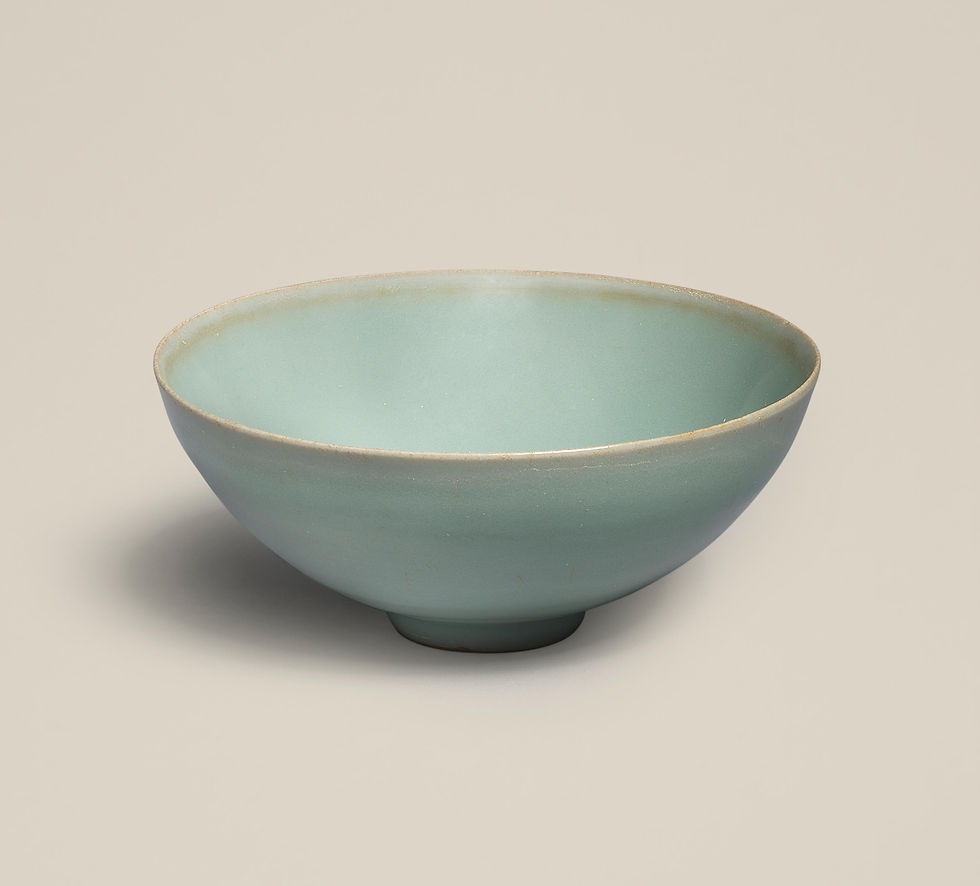拍賣筆記 vol.144 邦瀚斯倫敦:南宋龍泉窯官式青釉碗 - A Southern Song Dynasty A Longquan Celadon-Glazed 'Kinuta' Bowl
- SACA
- Mar 27
- 4 min read

這件器物勝在造型(form),淡雅的顏色非常的細膩入微。此類無裝飾的做法稱為「無地」,從級別上是比沒有裝飾的器物高級,至少在茶道中是這麼流傳的。官家造型,或為宮廷訂單。
大多數青瓷器物的特徵在於其較深的橄欖綠色調,而此件拍品則獨具一格,其釉色更接近白玉一般柔和淡雅的青白色調。這種清新且瑩潤的釉色在日本被賦予一個詩意的名稱:「砧青瓷(kinuta)」,此名稱最初源自中國宋代傳至日本的龍泉窯青瓷器物,尤其是以其形似砧(kinuta,即搗紙槌)而命名的長頸瓶上的釉色。
南宋 龍泉窯青釉碗
A LONGQUAN CELADON-GLAZED 'KINUTA' BOWL
Southern Song Dynasty
INSTINCT & KNOWLEDGE A LIFE IN THE COMPANY OF SONG CERAMICS
15 5月 2025, 10:00 BST
倫敦,新龐德街
£80,000 - £120,000
來源:
倫敦古董商 Spink & Son Ltd.
Emmanuel Christofides (1928-2020),雅典和倫敦,約於1970年代從上處獲得
著錄:D.Priestley和M.Flacks,《A Life in the Company of Song Ceramics》,倫敦,2017年,第36-37頁,編號12

大多數青瓷器物的特徵在於其較深的橄欖綠色調,而此件拍品則獨具一格,其釉色更接近白玉一般柔和淡雅的青白色調。這種清新且瑩潤的釉色在日本被賦予一個詩意的名稱:「砧青瓷(kinuta)」,此名稱最初源自中國宋代傳至日本的龍泉窯青瓷器物,尤其是以其形似砧(kinuta,即搗紙槌)而命名的長頸瓶上的釉色。
參見現藏東京國立博物館一件南宋時期的青瓷碗,名為「馬蝗絆(Bakōhan)」(館藏編號TG-2354),該器的釉色與本拍品極為相似,為室町幕府將軍足利義政(在位1449-1473)特別珍愛之物。值得注意的是,這件釉色與本拍品類似的青瓷碗備受將軍珍惜,甚至在不慎破裂後,將軍仍將其送回中國,希冀能以同等品質的器物替換。然而,由於中國在15世紀時已不再生產如此優質的青瓷,因此只能將破裂的碗以金屬鉗補釘後送回日本。這件瓷碗因而在日本身價倍增,其鉗釘形似一隻馬蝗(蝗蟲),極富特色,展現了「侘寂」美學所強調的殘缺之美,並因此獲得「馬蝗絆」之名,其裂紋反而轉化為備受稱頌的特色。
「砧(kinuta)」一詞原本特指形似搗紙槌的瓶器(參見本次拍賣會中拍品編號9號),因其造型神似日本傳統搗紙工具「砧槌」而得名。但隨著時間推移,「砧」逐漸演變為更廣義的術語,不再侷限於器形,而是用以形容所有具有玉質般迷人釉色的青瓷器物。這種晶瑩剔透、柔和雅緻的釉面,體現出龍泉青瓷精妙的藝術價值與審美境界,使之在當時乃至後世都備受珍視。
參考類似一例龍泉窯青瓷碗,宋代,呈斗笠形,見B. Gyllensvärd,《中國陶瓷:Carl Kempe收藏》,斯德哥爾摩,1964年,頁55,圖117。另參浙江省博物館藏一例南宋龍泉窯青瓷碗,見《世界龍泉:龍泉青瓷與全球化》,卷二,北京,2019年,頁55,圖20。

A LONGQUAN CELADON-GLAZED 'KINUTA' BOWL
Southern Song Dynasty
Elegantly potted rising from a short, inward-tapering foot to deep rounded sides, covered overall in a subtle bluish-green glaze, thinning to a buff tone on the mouth rim, box. 14.5cm (5 3/4in) diam. (2).
While most celadon wares are characterised by their darker olive-green tones, the present lot stands out with a hue that more closely resembles the soft, pale green of pale white jade. This distinct and luminous glaze has been poetically termed kinuta by the Japanese — a reference to its resemblance to the glaze found on Longquan mallet-shaped vases that first arrived in Japan from Song dynasty China.
See a celadon porcelain bowl, named Bakōhan, Southern Song dynasty, with similarly coloured glaze, which was a particular favourite of Shogun Ashikaga Yoshimasa (r.1449-1473), in the Tokyo National Museum (acc.no.TG-2354). It is interesting to note that the bowl with a similar colour glaze to the present lot was so highly valued by the Shogun, that when it accidentally cracked, the Shogun sent it back to China to exchange it with another of the same quality. However, as celadon wares of such high quality were no longer made in China in the 15th century, they returned the bowl to Japan with the crack simply fastened by a clamp. The bowl's value increased significantly in Japan due to the addition of a large metal clamp, which, with its striking resemblance to a locust, exemplified the beauty of imperfection central to the wabi-sabi aesthetic. This unique feature led to the bowl being named Bakōhan, or 'Large-Locust Clamp', transforming its flaw into a celebrated aspect of its character.
Originally, the term kinuta specifically referred to the mallet-shaped vessels (see also Lot 9 in this sale), named after the kinuta, or paper-beating mallet, which their form was thought to echo. Over time, however, kinuta came to denote a broader category of wares, defined not by shape but by their alluring, jade-like celadon glaze. This shimmering surface, with its subtle translucency and depth, embodies the refinement and artistry that made Longquan celadon so highly prized, both in its time and for centuries afterward.
Compare with a related Longquan celadon-glazed bowl, Song dynasty, of conical shape with rounded sides, illustrated by B.Gyllensvard, Chinese Ceramics in the Carl Kempe Collection, Stockholm, 1964, p.55, no.117. Another related Longquan celadon-glazed bowl, Southern Song dynasty, in the Zhejiang Provincial Museum, is illustrated in Longquan of the World: Longquan Celadon and Globalisation, vol.II, Beijing, 2019, pp.55, no.20.














Comments